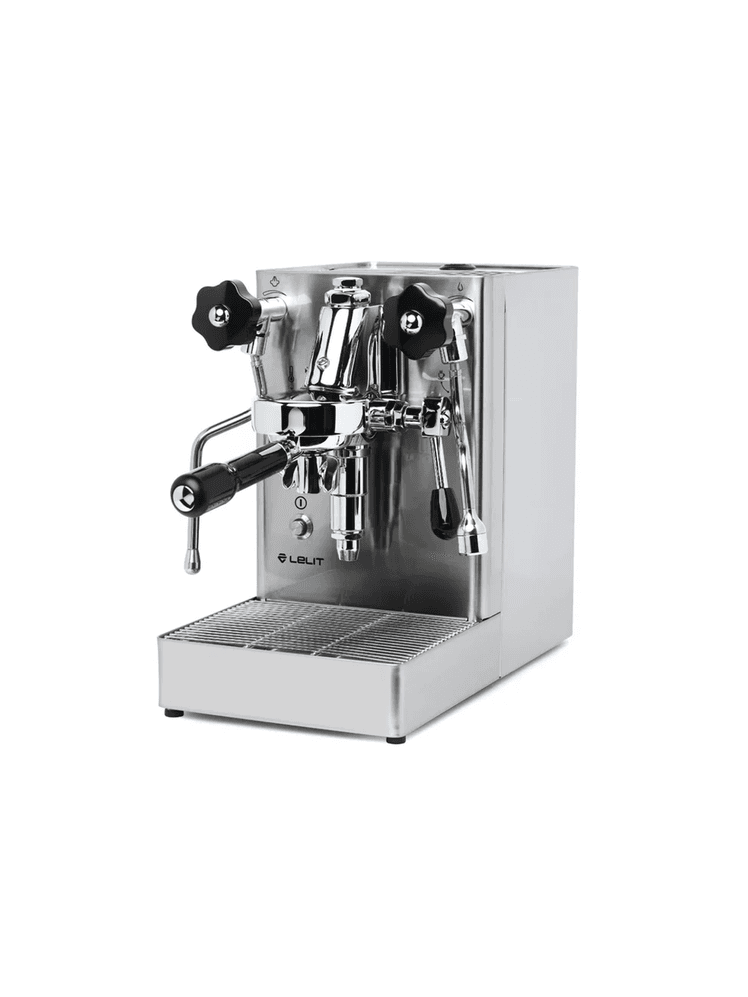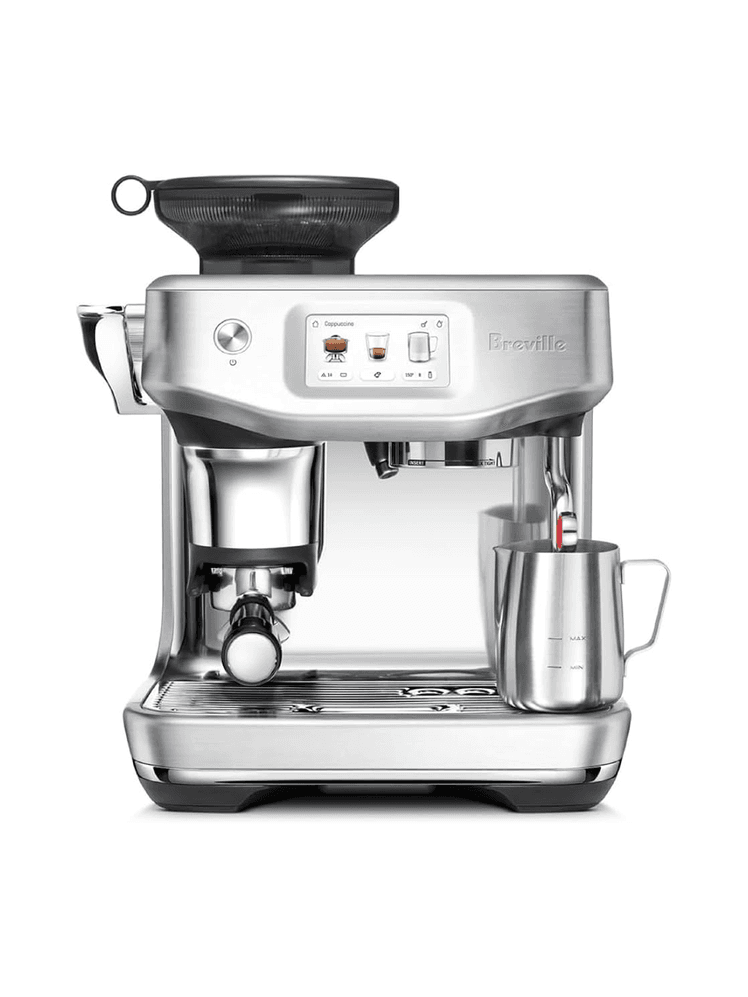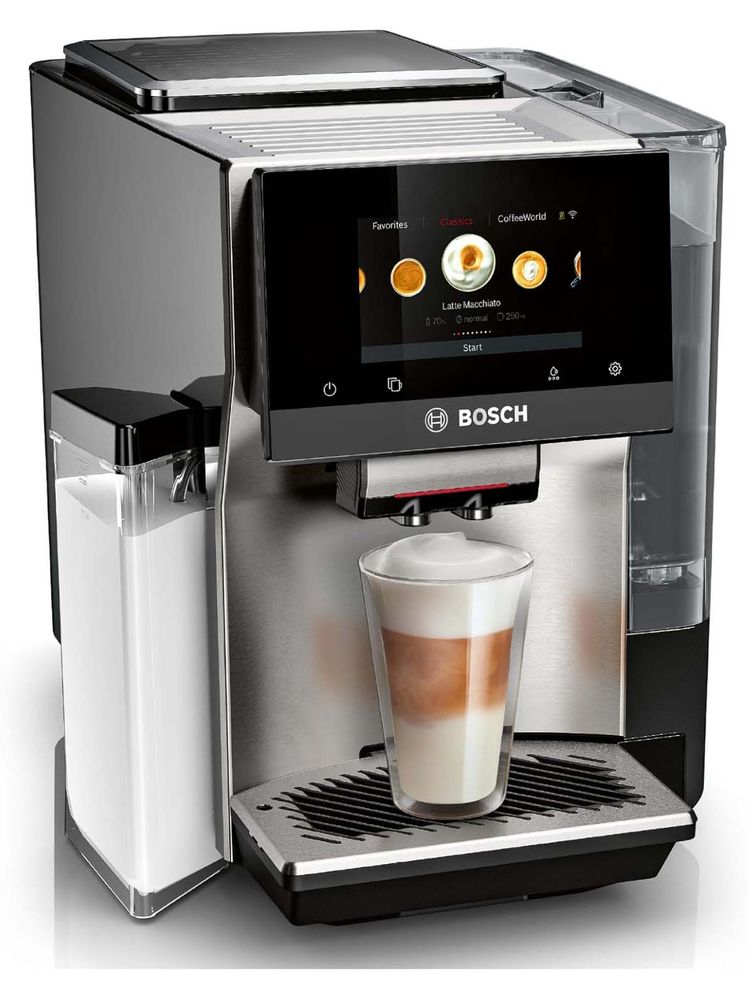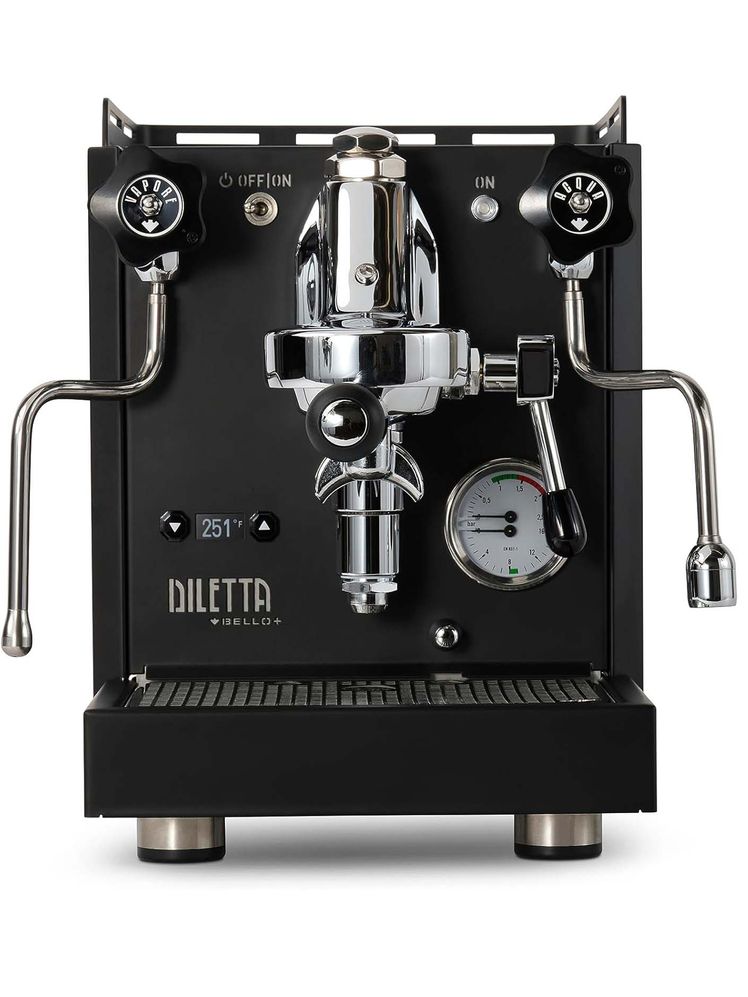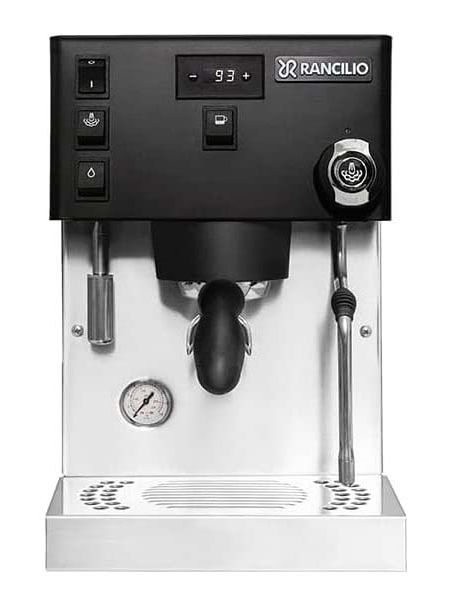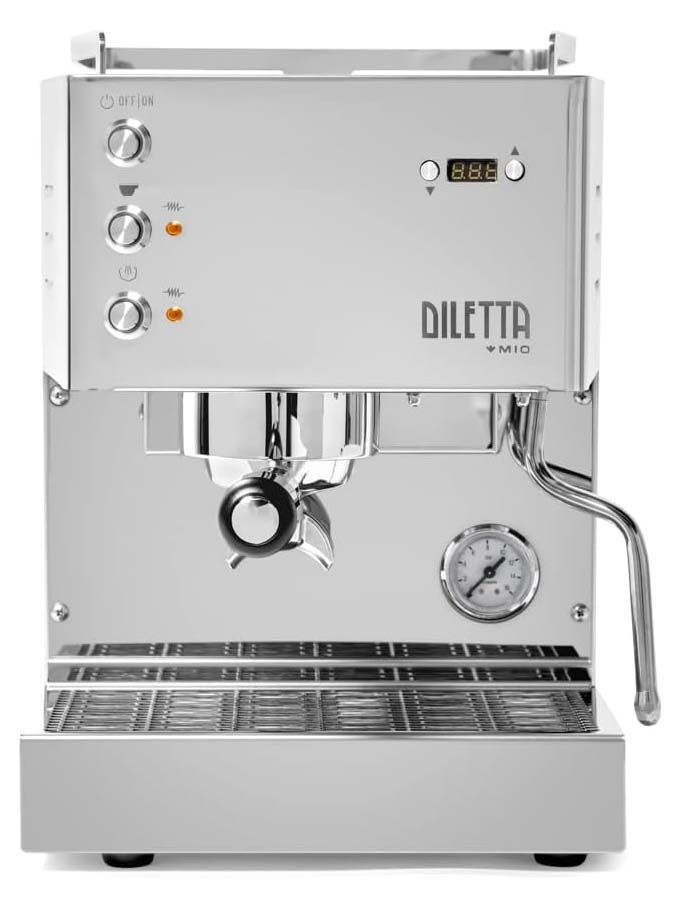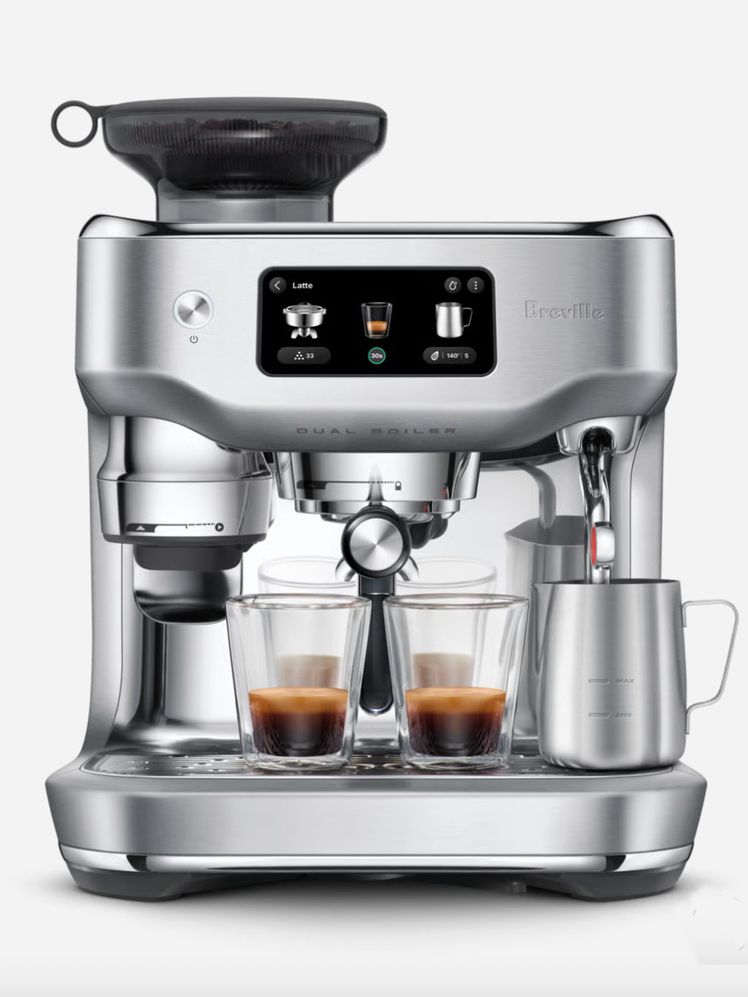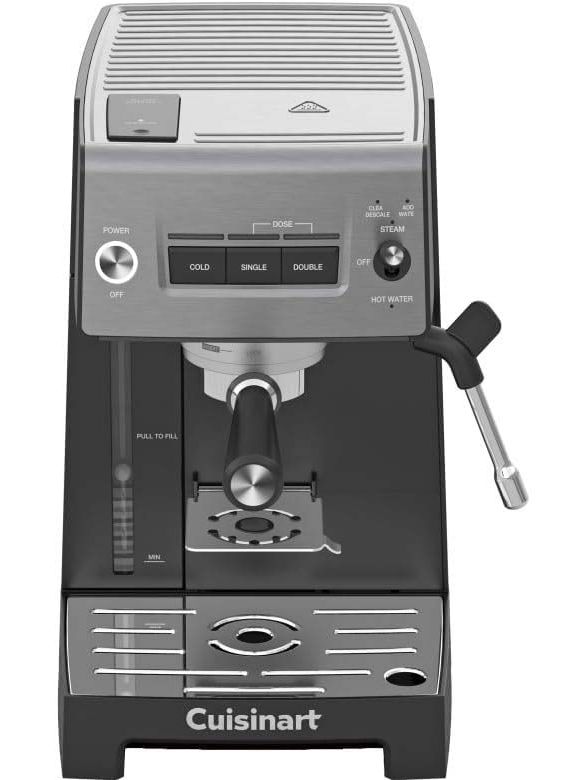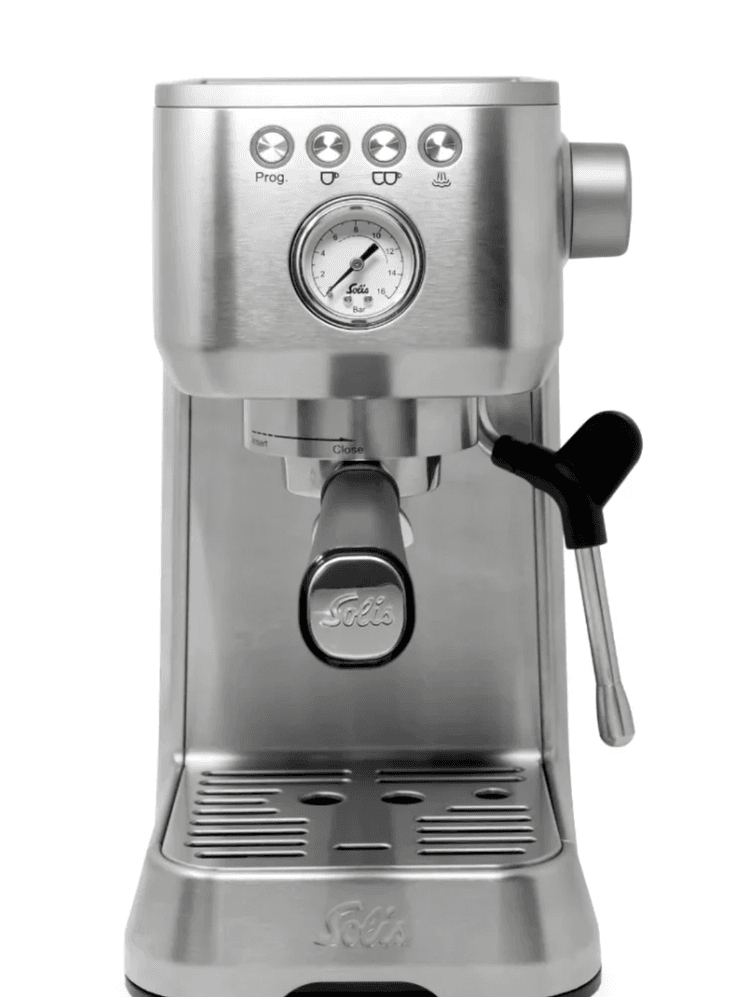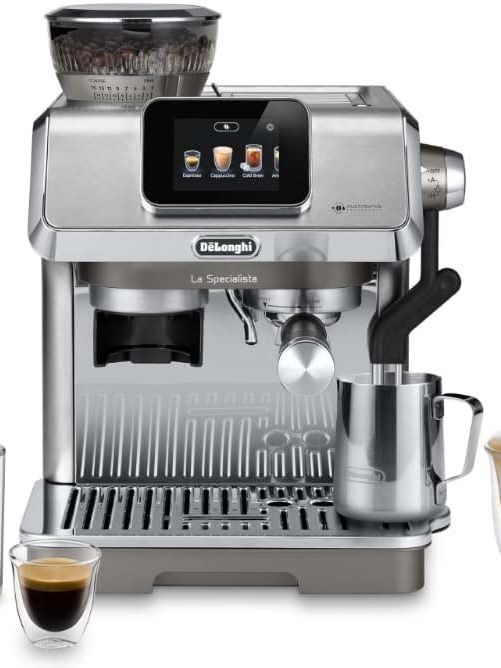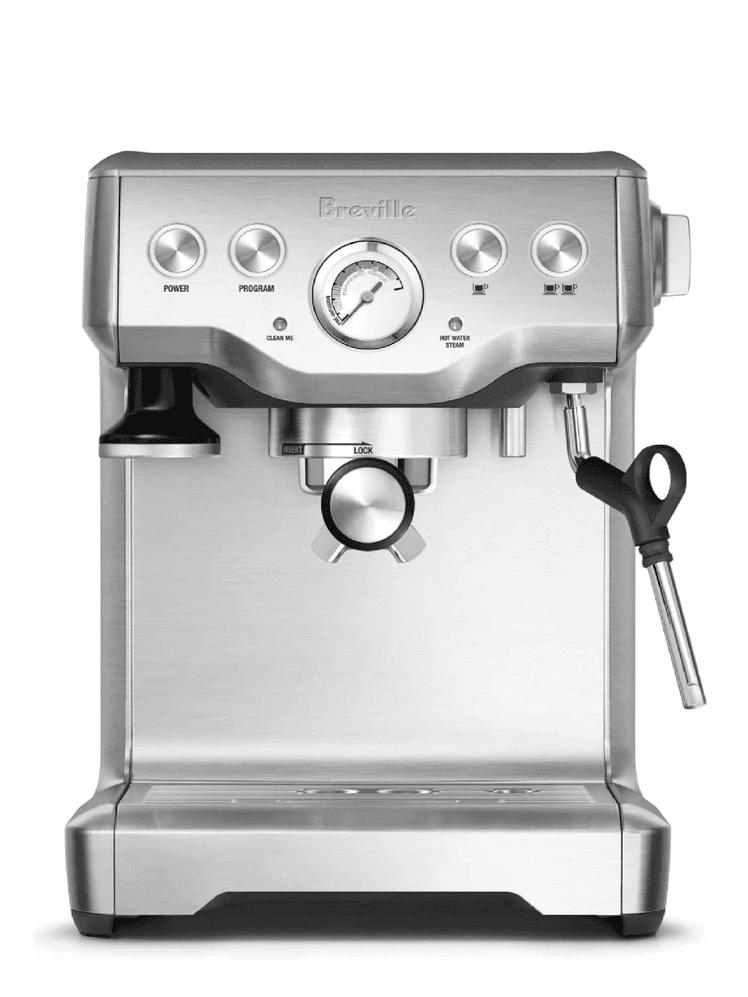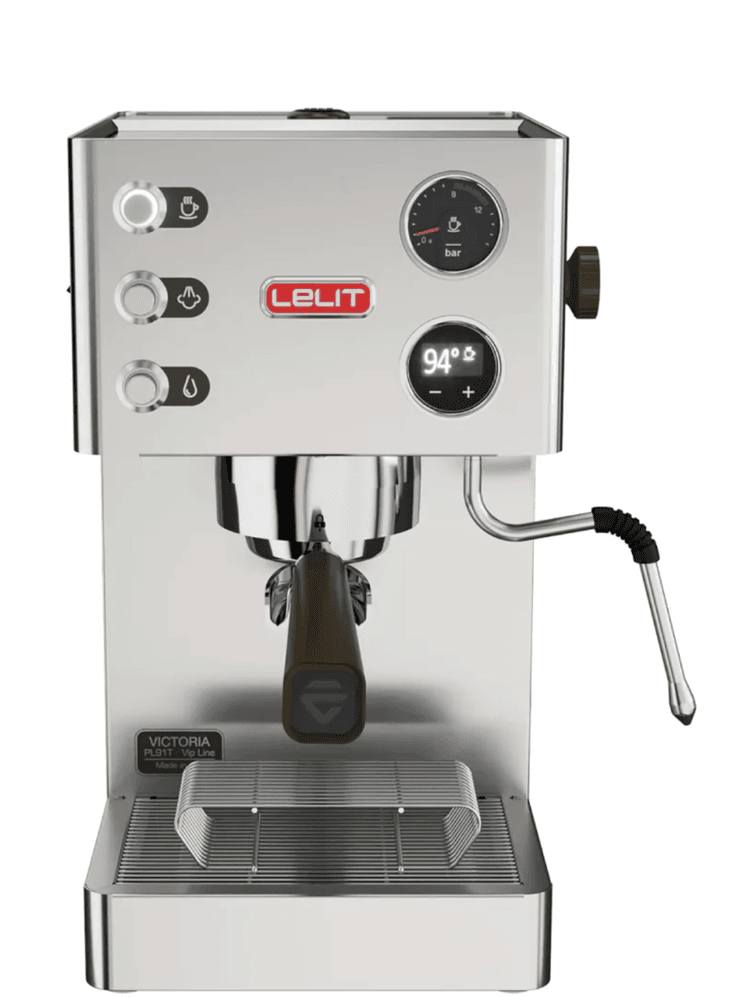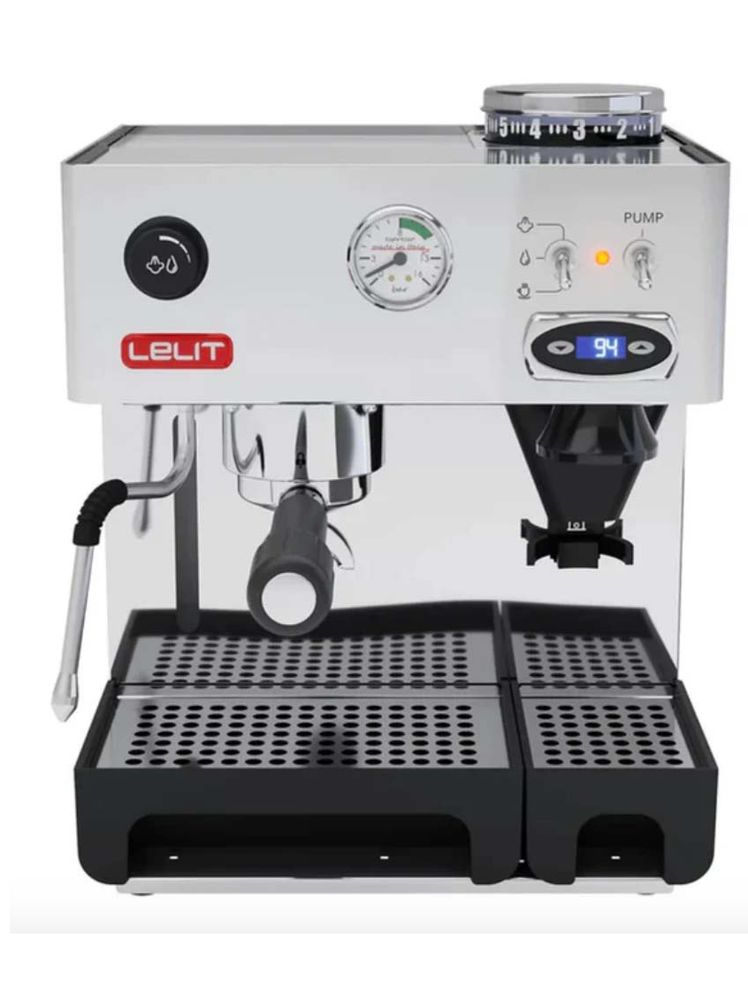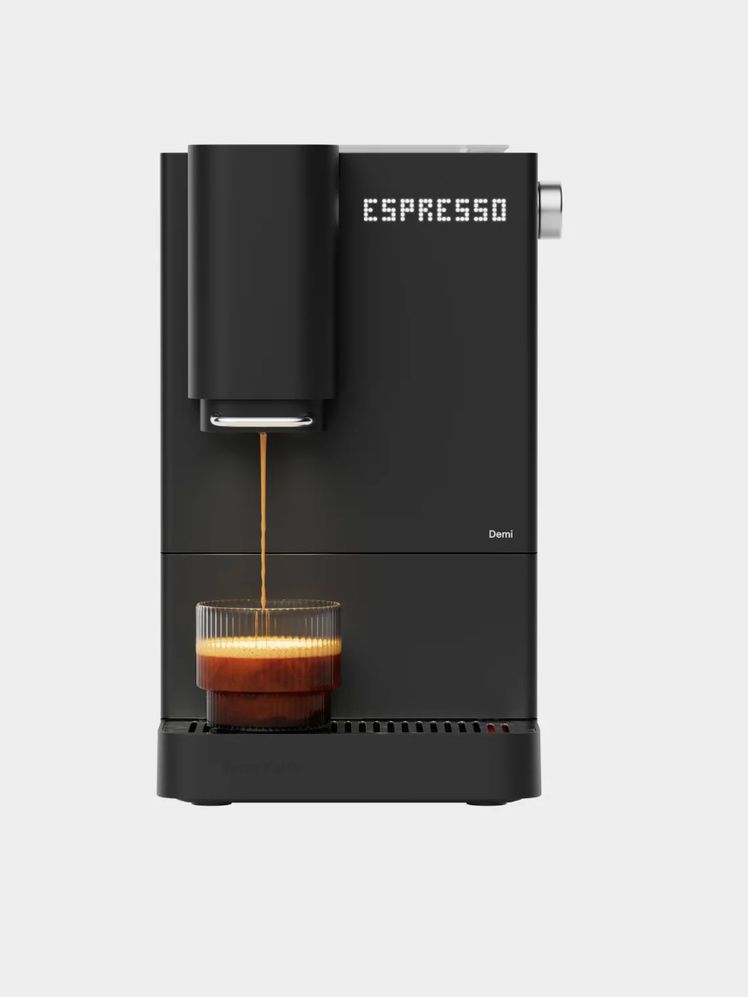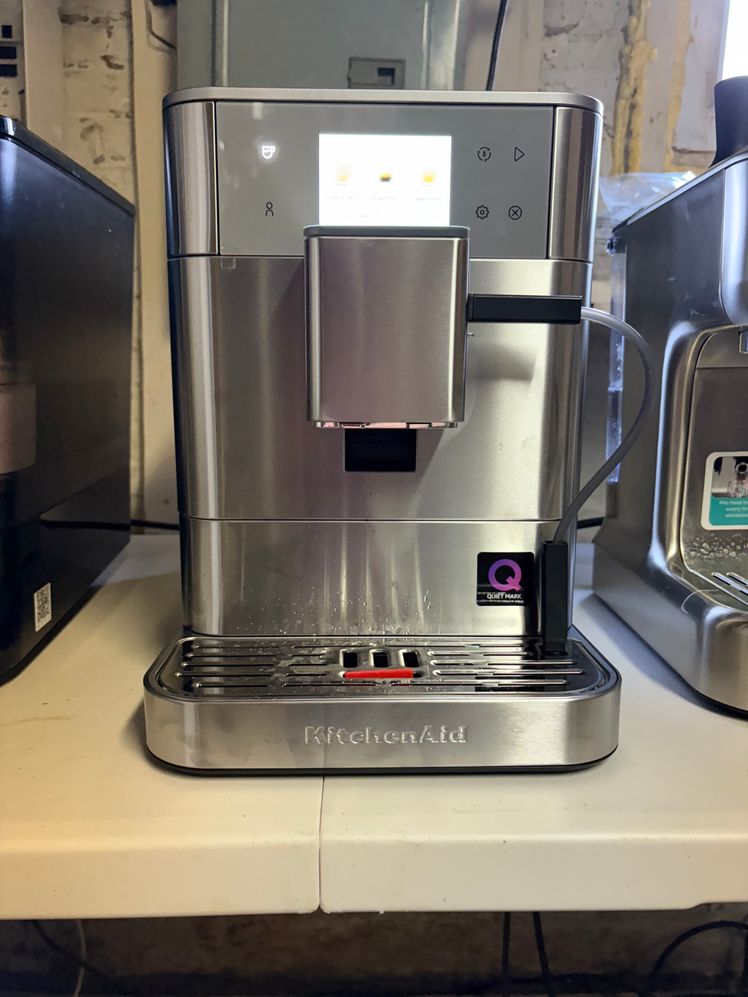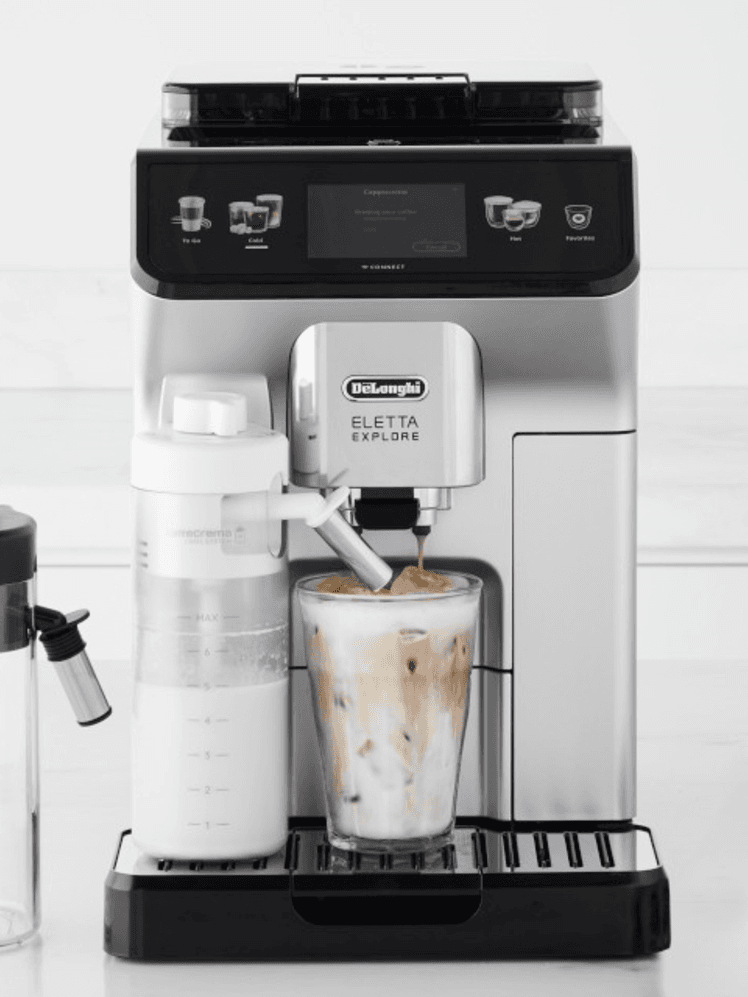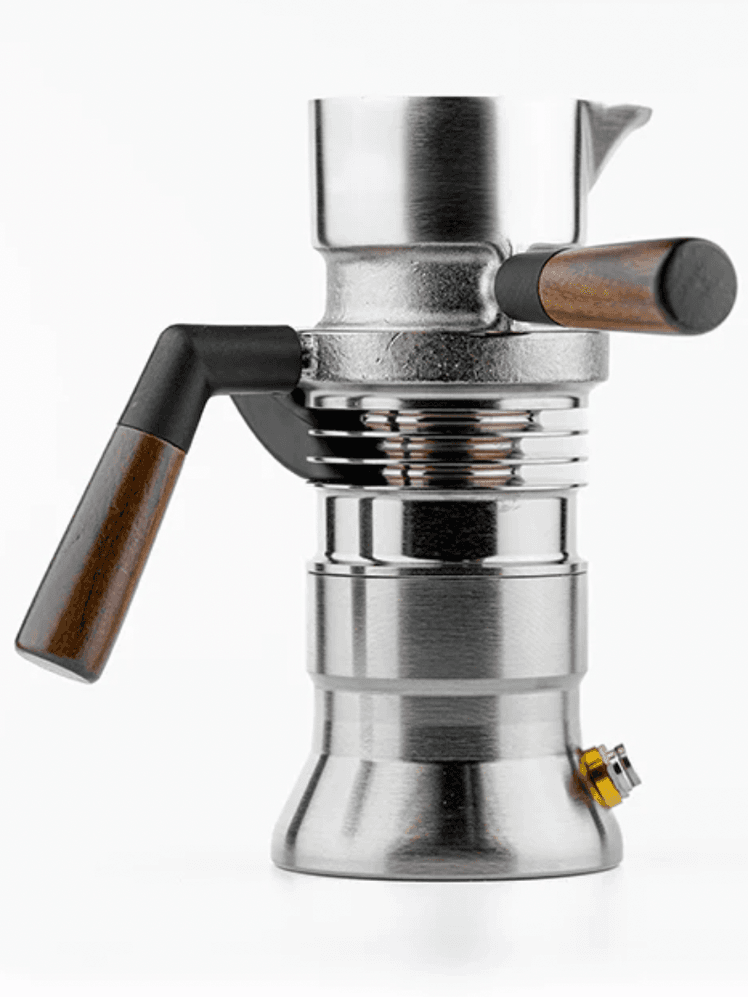Best Espresso Machines for Beginners & Coffee Nerds (2025)
Just a decade ago, a homemade morning cup of joe in the U.S. pretty exclusively meant drip coffee; the only people I knew with an at-home espresso machine were my friend’s very wealthy parents. Now it’s easier than ever to pull a double shot with a perfect layer of crema on top in the comfort of your own kitchen.
Companies like Breville and De’Longhi offer whole lineups of espresso makers, and high-end manufacturers like La Marzocco, famous for its commercial machines, have come out with home versions. At the same time, access to high-quality coffee beans is expanding. Put these two trends together, and the stage is set for an at-home espresso-making boom.
Our top picks
- Best espresso machine overall: Lelit MaraX
- Best budget espresso machine: Breville Bambino Plus
- Best espresso machine with a built-in grinder: Breville Barista Touch Impress
- Best super-automatic espresso machine: Bosch 800 Series
This means the barista-curious shopper is tasked with navigating a saturated, confusing market. There are tons of similar-looking machines that all have similar-sounding features (seriously, do an Amazon search for “espresso machine” and see what you get). That’s why we’re here, and hopefully why you’re here too. Keep scrolling down for more on all our top picks.
In this article
- More on our top picks
- How we tested espresso makers
- What to look for in an espresso maker
- Other espresso machines we liked
- Espresso machines we don't recommend
- What else do you need to make espresso?
- A few important espresso terms
New in this update: We finally feel comfortable recommending an espresso maker with a built-in grinder, the Breville Barista Touch Impress. Read more about why we avoided doing it for so long and why we changed our minds. We also tested Breville's new top-of-the-line machine and a slimmed down, less expensive option from Terra Kaffe.
Best espresso machine overall: Lelit MaraX
Lelit Mara X Espresso Machine
Pros and cons
Pros
- Very efficient heat exchanger
- Slow pressure build-up
- Effective steam wand
- Looks gorgeous
Cons
- Slow to heat up
- Can’t set PID to the degree
Specs
Size: 8.7" x 16.25" x 13.75"
Weight: 44.1 lb.
Water reservoir size: 84 oz.
Cup clearance: 4.5"
Colors: Stainless steel, black, white
Warranty: Two years
Good to know
We modded out the machine with Lelit's flow control kit. The kit allows you to control the pressure right at the brew head, which changes the flavor profile of the espresso. This kind of flow control is more common on machines that cost well over $2000, but the kit plus the MaraX still costs below that. This tweak allows us to make truly customizable shots (and it's just fun to play with to boot). If you're up for a little construction project—it took us a little less than an hour to disassemble and reassemble the machine—this is money well spent.
Breville acquired the Italian coffee company Lelit in 2023, and since then, the brand's machines have become more widely available. Which is great news for everyone because during our testing, the Lelit MaraX brewed the richest, most flavorful espresso. And the smooth layer of crema it left on top—perfection.
What we love: This machine uses a lever to turn the pump on and off, slowly increasing the pressure as your coffee brews; if you like to pre-infuse your grounds, you can do so by lifting to lever halfway. We also like that the steam wand is powerful without being unwieldy—we felt in control of the machine when texturing both dairy and oat milk. Steaming did take a little longer with the Lelit than it did with some other espresso makers we tried, but it was worth the wait. The frothy milk has lots of body but large bubbles (read: ideal for experimenting with latte art).
This is a heat exchanger machine, which means that the brewing water runs through a copper tube that heats it to the proper temperature. It doesn’t have a digital PID, though you can choose between three temperature settings: warm (197℉), hot (201℉), and very hot (205℉). The MaraX is also “mug friendly,” meaning it comes with plenty of clearance (4.5 inches) to fit your favorite cup under the nozzle. This was surprisingly rare in the prosumer machines we tried.
The last thing we absolutely loved about the MaraX is the way it looks. Unlike lots of high-end espresso machines that have a more industrial look, this one features soft wooden accents that feel right at home in a cozy kitchen.
What we'd leave: It’s missing a few features, like the aforementioned digital PID or a shot timer. The espresso we brewed was so good that we didn’t miss these features much, but we found them helpful on machines that did have them.
It also takes a long time to heat up—just under 20 minutes. That’s not unexpected—nicer espresso machines tend to take a long time to warm up because they need to stabilize the temperatures in their boilers—but it's something to be aware of if you need your first shot of caffeine within minutes of leaving your bed.
The best budget espresso machine: Breville Bambino Plus
Breville Bambino Plus Espresso Machine
Pros and cons
Pros
- Excellent for espresso beginners
- Great automatic milk steaming
- Tiny footprint nice for small kitchens
Cons
- Not very customizable
- No pressure gauge
Specs
Size: 7.7" x 12.6" x 12.2"
Weight: 11 lb.
Water reservoir size: 64 oz.
Cup clearance: 5"
Colors: Stainless steel, damson blue, and black truffle
Warranty: Two years
Food director Chris Morocco is into coffee. Like, really into coffee. Packs-coffee-beans-in-his-luggage into coffee. But he's quick to recognize that not everyone wants to do a deep dive into espresso. “I see [making espresso] as a cascading set of decisions,” says Morocco.
He thinks most people don’t want to deal with too many variables when they’re making coffee in the morning (some people don’t want to deal with any variables, and for them he suggests a Nespresso Vertuo Plus; even though it's a pod coffee maker, it still makes what Morocco thinks is a good cup of coffee). But if you can get over the hump of sourcing and grinding your own coffee beans, he points to the Breville Bambino Plus. This machine asks very little of you—you only need to load the portafilter with beans a push a button. The Bambino Plus comes with double-walled filter baskets, so you’ll be guaranteed a beautiful layer of crema every time.
What we love: You can find the above features on plenty of mid-priced espresso makers, but what sets the Bambino Plus apart is its ability to froth milk automatically. Simply place a jug of milk under the steam wand, set the level of foam you want, and push the steam button. The machine takes care of the rest. It also heats up in a flash—about 5 seconds—so you don’t have to wait for your morning coffee.
You can make some adjustments to the Bambino Plus if you want a more hands-on experience: You can adjust the brew temperature between low, medium, and high; set your own brewing time; and switch the milk steaming to manual mode. But you don’t have to do any of that to get good coffee from this machine.
What we'd leave: It's missing a manometer—a pressure gauge—to let you know that you're getting a shot pulled with the right specifications. We found this machine brewed consistently, but generally prefer having that feedback available in a semi-automatic machine.
The best espresso machine with a built-in grinder: Breville Barista Touch Impress
Breville Barista Touch Impress Espresso Machine
Pros and cons
Pros
- Excellent for espresso beginners
- Great automatic milk steaming
- Quality Baratza burrs in built-in grinder
Cons
- More expensive than other built-in grinder machines
Specs
Size: 14.2" x 13.4" x 16.3"
Weight: 24 lb.
Capacity 12 oz. bean hopper, 67 oz. water reservoir
Cup clearance: 4"
Colors: 10
Warranty: Two years
This is a tough one. We’ve resisted, for years, recommending anything with a built-in grinder. That’s because those grinders just weren’t that good. Their burrs were of lesser quality than even inexpensive conical burr grinders and they came with comparatively few settings. However, a few years after Breville acquired grinder company Baratza it begin integrating some of the brand’s higher quality parts in its espresso machines.
What we love:
The Barista Touch Impress is the least expensive of the Breville machines that include Baratza M2 burrs (the same ones used in the Baratza Encore ESP). It includes 30 grind settings, skewed toward the espresso end of the spectrum, which should be enough for most people. It comes with a “smart tamping” lever that ensures the proper pressure when you’re compressing a puck of coffee, and dial-in features will let you know how you need to adjust the grinder settings to produce the best shot of espresso.
Beyond that, the Touch Impress has the same features we like in Breville’s whole run of newer espresso makers: the quickest heating on the market thanks to its Thermojet system, superior automatic milk steaming with presets for eight drinks and slots for eight more of your own creations, and a brewer that puts out reliably delicious shots of espresso.
What we’d leave:
This is undeniably an expensive machine. Breville’s entry level built-in grinder machine, the Barista Express, is half the cost and it’s not bad. But grinding for espresso is so important we think you should make sure you have higher quality components. (If you're thinking about the Barista Express or any other Breville machine, here's our guide to the brand's whole lineup.)
The other thing about this espresso machine (and any machine with a built-in grinder) is that, if the grinder fails, you can’t just send it off to get fixed. You have to send the whole machine to get repaired. We didn’t experience any issues with the Touch Impress, and it comes with a two-year warranty, but when you consolidate all your coffee equipment into one piece you risk needing to replace it all at once instead of just being able to fix the part that broke.
A note: Older models of the Bambino Plus don't have a hot water dispenser and you may see that missing feature referenced online. But that's not the case anymore! To use the steam wand as a hot water dispenser in newer Bambino Pluses hold down the “one shot” and “steam” buttons. Just make sure you have something under the wand to catch the water.
The best super-automatic espresso maker: Bosch 800 Series VeroCafe
Bosch 800 Series Verocafe with Attached Milk Container
Pros and cons
Pros
- Can make dozens of different drinks
- One-touch functionality
Cons
- Espresso shots taste a little flat
- Big countertop footprint
Specs
Size: 15" x 13.9" x 18.4"
Weight: 21 lb.
Water reservoir size: 81.2 oz.
Cup clearance: Variable
Colors: Black and stainless steel
Warranty: Two years or 7,000 cups
Sometimes you don’t want to spend the time to weigh out your coffee beans, get the grind just right, or consider how many pounds of pressure you’re tamping with. You're gonna love the world of super-automatic espresso machines. Super-auto machines not only take care of all three of those issues, but the good ones will foam up milk for flat whites, cappuccinos, and, in the case of the Bosch 800 Series, dozens of other drinks.
Bosch’s latest entry into the coffee world jumped to the top of our automatic coffee maker list by dint of its extreme versatility. It can make over three dozen different kinds of drinks, including a bunch of European coffee drinks you may have never heard of (any großer brauner fans out there?). But the most impressive part is that the drinks really do show a lot of subtle differences in their size, strength, and texture.
What we love: In terms of the actual espresso it makes, the Bosch is in line with the best fully automatic espresso makers we’ve tried, including the Jura E8, the De’Longhi Eletta Explore, the Miele CM5310, and the Philips LatteGo. That isn’t to say it’s as good as what you can get from the Lelit MaraX, or even the Breville Bambino Plus. No automatic machine can produce espresso quite as good as a nice semi-automatic machine; that’s a trade-off you need to make for the convenience.
One thing you do control? You’ll have to decide if you want an attached, detached, or no-milk container. Skipping the milk container entirely really isn't an option; the whole point of having a super-automatic machine is to make different milk drinks. But choosing the detached container will save a couple hundred dollars. We found the milk does foam up better with the attached container, but its value is really up to you.
What we'd leave: Like most super-auto machines, Bosch's is big. It takes up nearly twice as much space on the counter as the Bambino Plus does.
The Bosch 800 Series putting out milk for an oat flat white.
Noah Kaufman
How we tested espresso makers
In short, we made a lot of coffee. We brewed at least 10 shots on every machine and repeatedly steamed both dairy and oat milk as well. Machines that performed well after that initial round got continuous use over the course of a month; our top picks are still in regular use.
But testing espresso makers is a little different than testing, say, nonstick pans or toasters. Even asking “what is the best espresso machine” is sort of like asking “who is the best painter.” There’s not a single answer to that question because people want very different things from their espresso machines. Some want the full, hands-on barista experience of a prosumer machine, some need an affordable and easy-to-use option, and some need something completely self-contained with one-button operation. So we picked options that accommodate a range of prices and experience levels.
What to look for in an espresso maker
Does it make tasty coffee?
Perhaps this goes without saying, but it's table stakes for an espresso machine to make a shot of espresso that has nuanced flavors, full body, and a rich crema on top. Machines achieve that with the right mix of temperature (about 200℉) and pressure (about 9 bars). Don’t be fooled by listings that say an espresso maker has enough power to reach 20 bars of pressure. Typically that kind of claim is code for the fact that it doesn’t actually regulate its pressure very well.
Does it steam milk well?
Besides pulling shots, these machines' other main job is steaming milk. A good steam wand should produce smooth, rich milk, without large bubbles. It should also heat the milk evenly; you don't want some milk scalded while some of it's barely warm (we've had it, it's gross). Finally, we prefer wands that can handle alternative milks in addition to dairy.
Ease of use
Making espresso drinks can be a finicky process—weighing your coffee beans, getting the grind right, tamping the beans with the right amount of pressure, and that’s before you even get to brewing. Anything a machine can offer to make the process easier and more reliable is welcome. That could be a quick heat up time, brewing on a timer so you don’t have to start and stop the process, or an easy-to-control steam wand for texturing milk.
Price
Here’s the bad news: With espresso makers, you get what you pay for. According to Isaiah Sheese, owner of the three Archetype Coffee shops and roasteries in Omaha, Nebraska, “anything under $500 and you’re not going to get that great of a machine.” Generally, that’s because those machines lack things like PIDs. The Breville Bambino Plus sneaks in under the $500 mark, but it's the exception rather than the rule.
Does it look good?
This sounds superficial, but whatever espresso maker you pick, it’s going to be sitting on your counter for everyone to see for years, so you should like the way it looks.
Other espresso machines we tested and liked
We liked all these machines; in fact, several were winning picks in earlier versions of our testing. They span styles and price points, and we think they all represent good buys, even if they aren't our top picks.
Diletta Bello+
Diletta Bello +
We’re splitting hairs in naming the Lelit MaraX our top pick over this machine, the Bello+. The Bello+ has a few features the MaraX doesn’t, like an adjustable digital PID, a shot timer to help you hone your shots, and programmable pre-infusion. It also heated up faster than the MaraX, clocking in at around 11 minutes compared to 20. But to us, those bells and whistles are nice to have, not essential. You can get a shot timer from an affordable espresso scale, and pre-infusion can be done manually on many machines, including the MaraX.
Where the Bello+ fell short was its steam wand. It was the most powerful we tested, which made it too easy to overwork the milk. It’s also more expensive than the MaraX, which is ultimately why it didn’t earn a top spot. That said, it’s still an excellent and consistent espresso machine.
Rancilio Silvia Pro X
Rancilio Silvia Pro X
A favorite of Bon Appétit food director (and fellow traveler in coffee nerdom) Chris Morocco, the Rancilio Silvia Pro X is a lovely machine to use. It’s a dual boiler (unlike the Lelit MaraX, which has a heat exchanger setup), so the water used to steam milk is always at the ready and at a different temperature than the brewing water. It has a useful pressure gauge, which a previous Rancilio model did not, and an adjustable PID controller you can set to the degree.
Ultimately, we thought both the coffee tasted better and the milk frothed a bit better using the Lelit, but we are willing to admit some subjectivity there. The Rancilio also has a more industrial look that may not fit quite as nicely in your home coffee bar. In terms of performance, though, we have no issues with the Rancilio Silvia Pro X and recommend it.
Diletta Mio
Diletta Mio
A step down from the Diletta Bello+, the Mio is another prosumer machine that pulls a nice shot and makes a nice cappuccino. The Diletta Mio uses a thermoblock heater for steam instead of the heat exchanger of the Lelit or the dual boiler of the Rancilio, which keeps both the cost and the weight a bit lower than they otherwise might be. This machine also heats up much more quickly than its competitors—under 10 minutes, which is super speedy for a higher-end espresso machine.
However, we had an issue with longevity. After about six months of use, we started having trouble with the water temperature dropping. It took very regular flushing to keep things on the up and up. One other issue with this Diletta is very low cup clearance, which meant that for milk drinks, we needed to brew into a shot glass instead of the cup we intended to drink out of.
Breville Oracle Dual Boiler
Breville Oracle Dual Boiler
We expected a lot from a $3000 machine and the Oracle Dual Boiler did deliver. Breville’s Oracle line occupies sort of a strange space in the espresso maker world. They are, in almost every way, super automatic machines: They grind, they tamp, they brew, and they steam milk. However, Oracle machines use 58mm portafilters and you have to move them from the grinder section to the brewing section.
The Oracle Dual Boiler is a step up from previous Oracle editions though. It’s widely customizable with presets for the standard drinks we’re used (flat whites, lattes, americanos, cappuccinos), along with presets and instructions for newer options (espresso martinis, for example). The dual boiler means that one boiler controls brewing and one controls milk steaming and you can do both simultaneously. That’s not so important in the home setting—it’s more of a priority in a café setting where baristas need to make lots of drinks at once. But it’s a nice feature and, by dedicating one boiler to pulling shots it helps keep a more stable temperature at the brewhead.
The big upgrade though, is the Dual Boiler’s manual mode. Older Oracle machines only had single press, automatic brewing options. If you select the manual mode you can control things like bloom time or pre-infusion on the fly instead of pre-programming them. It still uses a touchscreen interface (which definitely takes some getting used to) but you can use the Oracle Dual Boiler more like other high end espresso makers like our top pick from Lelit.
Cuisinart EM-320
Cuisinart EM-320 Espresso Machine
After more than half a decade of espresso machine testing, one idea has become almost axiomatic: Cheap espresso machines are just bad. But with this Cuisinart, that miraculously isn’t the case. At under $400 at the time of writing (and often on sale for even less), this petite machine pulled relatively rich espresso shots with a 15–20 second extraction time that outperformed everything else in the sub-$400 range. The EM-320 even comes with a bottomless portafilter, which is unheard of for a machine this cheap, likely because it makes it impossible to hide any cut corners or shortcomings. It’s a bold choice, and one that’s mostly backed up by the machine’s performance.
Other nice features include a removable water tank that pulls out from the front and enough cup clearance to fit a 20-ounce travel mug. It also has a cold extraction option, which works about as well as any we tested. That said, these settings across the board still can’t match the flavor quality of more time-consuming methods like immersion cold brew or flash chilling.
The main reason the Cuisinart didn’t make our list of top picks is its steam wand, which didn’t perform nearly as well as its brewing operation. The milk texture came out uneven and typically quite thin. We still think that, for anyone who finds $500 for the Breville Bambino Plus high, this makes a good entry into the world of espresso machines, but making cappuccinos will take a bit more patience.
Solis Barista Perfetta Plus
Solis Barista Perfetta Plus
The Solis Barista Perfetta Plus is a tremendous budget machine. It has an adaptive PID (though setting it requires pushing a combination of buttons a la a cheat code in an old Sega Genesis game), which is practically unheard of at this price point. The built-in pressure gauge provides useful feedback, and we have to give a hat tip to its powerful steam wand, which outperformed some machines that cost hundreds of dollars more. And finally, it has one of the smallest countertop footprints of any machine we’ve seen.
Why don’t we have it recommended up at the top? We’ve seen it out of stock for long stretches, and don't want to leave you in a lurch.
De’Longhi La Specialista Touch
De'Longhi La Specialista Touch
Besides Breville, De’Longhi is the other big name you'll see again and again in the $500–$1000 home espresso machine category. The La Specialista Touch is De’Longhi’s latest answer to the Breville Barista Touch, and in our opinion, is the best offering from the brand yet. It brews nine different coffee drinks, both espresso-based and not.
It helps you dial in the grind using its built-in burr grinder and measures extraction time to guide you. You can also save settings for different beans, making it easy to switch between blends and maintain consistency. The machine features automatic milk texturing, though you can switch the steam wand to manual if you prefer full control. If we had to choose, we’d say Breville’s auto-steaming works a bit better, but the Specialista Touch reliably produces five distinct milk drinks: cappuccino, flat white, latte, and latte macchiato.
Like all De’Longhi machines with built-in grinders, it includes a screw-on funnel that fits over the portafilter, keeping the grinding and tamping process cleaner than what you get with many other brands.
It also includes a cold extraction setting, which runs slower than most and produces a smoother-tasting coffee compared to its hot brew. It’s not a standout feature for us, but it could be useful for someone who wants to experiment with cold coffee at home.
One note: During extended testing, the steam wand failed to work twice, though the issue resolved itself after turning the machine off and back on.
Breville Infuser
Breville Infuser
The Infuser is a slightly older Breville model from a time before they were including grinders on most of their machines. It's essentially the Barista Express without a grinder and we think that makes it a pretty strong option for its price range. It brews flavorful espresso and has a pressure gauge and an adequate steam wand. The dial that toggles between steam and hot water doesn’t feel quite as nice as the push-button operation of newer Breville machines, and because it’s older it can sometimes be a little harder to find in stores. Overall we think the Bambino Plus presents a better package of features, but if you find one of these on sale, we say snap it up.
Lelit Victoria
Lelit Victoria
The Victoria is a step down in Lelit’s lineup from the MaraX. It costs about 40% less, but we thought the tradeoffs for those savings were too much. It’s a single boiler machine without a heat exchanger, so we had to wait almost a full minute to steam milk after pulling a shot. And when we did steam milk, it lacked the texture we got from the fancier model. It does have a PID controller and shot timer, which are nice features, but ultimately we think you can get similar quality for less money with a mid-priced Breville machine.
Lelit Anita
Lelit Anita
We added Lelit’s Anita into our testing mix as part of the process of reevaluating the idea of built-in grinders and found a lot to like. The grinder is stepless, meaning you can make teeny tiny adjustments in order to properly dial in the grind for your particular beans. It’s also one of the least expensive machines we’ve tried with a digital PID controller. Most importantly, the espresso came out nuanced, flavorful, with a nice, thin layer of crema on top.
But there are challenging parts about using this machine. The Anita has a relatively small, 250ml boiler, which comes with its plusses and minuses. It can reach a stable temperature much more quickly than bigger, more expensive machines; we could start pulling shots in less than 10 minutes. It can also switch between pulling shots and steaming milk more quickly than most single boiler machines. However, because the boiler is so small the temperature drops quite quickly. That’s not great for pulling longer shots and makes steaming milk a real race against the clock. We also struggled to get enough body with dairy milk and couldn’t get oat milk to the consistency we wanted.
The tamping set-up isn’t great either. The machine doesn’t come with a tamper, instead, an attached plastic piece serves the purpose. You have to push the portafilter up rather than pressing down with a tamper, which is a messy process and makes an uneven puck until you get the hang of it. But, if you want the convenience of a built-in grinder, the Anita is still a good all-in-one solution, especially if you add your own tamper to your set up.
Terra Kaffe TK-02
Terra Kaffe TK-02 Coffee Machine
Terra Kaffe’s super auto machine is, hands down, the most handsome automatic espresso machine we’ve tried. The matte white model in particular gives a real modern, elegant look to whatever space it's in. But this is not a beauty contest. Fortunately for the Terra Kaffe, it actually made pretty good coffee (for a super automatic machine). Espresso didn’t taste flat, as it often can from super automatics, and milk drinks frothed up nicely. This machine is also easy to fill, clean, and empty, as the water tank and grounds container both come out from the front of the machine instead of the side or the back.
The TK-02 is incredibly user friendly with a huge intuitive touchscreen and an effective app. We will note that the standard cup of coffee, like the cups of coffee from every automatic machine we’ve tried, was underwhelming—hot and lacking in flavor. Ultimately, the reason we recommend the Bosch coffee maker instead of the Terra Kaffe is because it can brew everything the TK-02 can and then some. But if you’re in the market for a super automatic machine you’ll like what you get from the Terra Kaffe, particularly if you treat your kitchen as a bit of a show space for people to gather.
Terra Kaffe Demi
Terra Kaffe Demi
What to make of the new release from the maker of the most aesthetic automatic machine we’ve tried? It’s light and slim thanks to the fact that it does away completely with the ability to make drinks. Having a cappuccino at the push of a button is kind of the point of these super-automatic machines, so we have to dock points right there. However, what it does (espresso shots, lungo shots, americanos, and “drip” coffee) it does well.
That short list of drinks makes the Demi more akin to a Nespresso machine than the other super-autos we tested. But it offers meaningful upgrades to the Nespresso experience (although it offers them for more than double the price). Instead of Nespresso capsules you get to use fresh coffee beans, which, for as good as Nespresso pods taste, always makes better coffee. Within its short menu the Demi is also much more customizable than a Nespresso machine. You can change the volume and the brewing temperature for each drink. We also think it looks like more a statement piece than any Nespresso models, though for $700, it should.
KitchenAid KF7 Fully Automatic Espresso Maker
KitchenAid Fully Automatic Espresso Machine KF7 with Milk Attachment
As we’ve continued to test super automatic espresso makers over the years, we've found the new offerings from more established brands make better and better coffee. KitchenAid’s KF7 is a good example. The espresso shots came out rich and a little fruity, much like the shots we enjoyed from Bosch and Jura machines. The true test of a super auto as far as we’re concerned is its performance with milk drinks and the KitchenAid did well there too.
The KF7 is the mid-tier machine from KitchenAid that comes with a milk container attached to the brew head with a hose. The flat white came out a little more like a mini-latte than we would have liked but the cappuccino had a rich head of smooth foam. One KitchenAid feature that we’d tell every maker of a super auto machine to consider adding is the removable bean hopper. It’s impossible to tell in super automatic machines how much coffee is left in the hopper and you can easily end up with half the beans you need as it runs to empty. Not only does the removable hopper solve for that, it also makes it easy to clear away old stale beans and replace them with fresh ones.
De'Longhi Eletta Explore
De'Longhi Eletta Explore
The fancier of the two De’Longhi super automatic machines we tested delivered once we got it dialed in. The burr grinder on the Eletta Explore has 13 settings and we found we had to set coarser for espresso than we would have thought, around 6. With the milk container attached it can make around 50 kinds of drinks, though many of them are just iced versions of the hot drinks. The touchscreen is intuitive and provides step-by-step instructions when necessary. The water tank is big enough that a two-coffee-drinker household should only need to refill it once during a week. Both the straight espresso and the black coffee tasted a bit flatter than the drinks from the Bosch, and the foam was a little thinner. This machine can, however, make cold foam if you like iced cappuccinos.
Flair Pro 2
Flair Pro 2
Using the Flair Pro 2 is an entirely different experience from every machine we’ve covered up to this point. That’s because this is a fully manual lever espresso maker. That means you have to heat the water and produce the necessary pressure for brewing by yourself. There were some messy moments as we figured out how to use it, but the Flair did produce some truly delicious espresso. The trick, which someone from Flair shared with us, is to allow a brief period of pre-infusion during which you don’t pull too hard on the lever. It lets the pressure build more slowly.
A lever machine like the Flair is a commitment and the small 46mm filter basket is a little tedious to fill. But if hands-on experimentation is your thing, this is a fun machine. It’s also great to travel with: It comes apart and fits into a case about the size of a large tablet.
9Barista
9Barista Espresso Machine
As with the Flair, it doesn’t make much sense to compare the 9Barista to say, a Breville or De’Longhi machine, because it’s a stovetop espresso maker. If you’ve ever used a Mokapot, it works sort of like that, except much better. Its boilers actually produce the correct pressure for an espresso shot and those shots tasted better than everything except the very best prosumer models we tested. The little brewer is dense, it weighs in at almost four pounds (a mark of quality), and if you’re up for a more manual experience you won’t be disappointed.
Espresso machines we don't recommend
Some of the machines on this list performed adequately. Some even made delicious coffee. We also know that there are entries here that have passionate devotees. But for each one, we thought the negatives outweighed the positives enough that we'd encourage you to consider one of the espresso makers above instead.
The Profitec 500 took the longest to heat up of the high-end machines we tested at close to 24 minutes. It was also one of the most finicky. Dialing in a shot took the longest and the machine demanded a very precise grind and tamp that we needed to adjust sometimes on a day-to-day basis. If you’re willing to take on all that, the machine is a beautiful feat of German engineering. The look is a little steampunk for our liking, but that’s a personal thing.
Like most of the prosumer machines we tried, the Rocket Appartamento uses a heat exchanger to keep water hot for brewing and steam. It’s a little slower than most though, so there was a longer wait between brewing and steaming milk. The included tamper, which could be replaced, didn’t fit flushly in the portafiler that came with the machine and left some loose coffee on the edges. It doesn’t have a PID controller (though a newer model that will get future testing does allow some adjustment) and it also has a bigger footprint than our top pick.
The Express Impress was a big jump forward in technology for Breville. This was the company’s first machine to use a combination of smart grinding and tamping to let you know the grounds in your portafilter were all set for a good shot. After grinding, the machine measures whether it’s able to compress the coffee grounds with the right pressure. If it can’t compress them enough it means the grind is too fine or there is too much coffee. If it compresses too much, the reverse is true. It worked wonderfully for a while in our testing, providing useful feedback. The espresso and milk steaming worked at the same level they do in all the mid-priced Breville machines we tested—both consistently good.
The problem we ran into with this machine was that it began jamming up with lighter roast beans. We asked Breville why this is and didn’t get a definitive answer. But issues like this are why we typically stay away from espresso machines with built-in grinders. They tend not to have as many settings or as much power as stand alone grinders. As noted above, Breville has been improving their built-in grinders with the same burrs used in Baratza grinders, but only on models at the Barista Touch level and above.
The one caution we’d have about this machine is the same one we mentioned above about built-in burr grinders. But the Barista Express is an affordable espresso machine that makes the kind of consistent coffee Breville is known for. The grinder itself is a little annoying to adjust—you have to free hand the grind time on a dial that is just labeled “less” and “more,” but we were able to get it in range after about 15 minutes of trial and error.
The La Specialista Arte has a built-in burr grinder as well as a built-in hot water dispenser, which you can select with a dial near the group head. The steam wand wasn’t quite as powerful as those on Breville machines, but it still produced some texture to the milk.
A small accessory that makes a difference is the included funnel. It attaches to the portafilter and keeps the grinding process cleaner than it would be otherwise. Aftermarket funnels are available for most machines, but it’s a nice accessory to have in the box. One thing to know about semi-automatic De’Longhi machines is that their portafilters are a slightly different size than many other machines. You could, for example, use the Solis portafilter in a Breville machine or vice versa. But the De’Longhi portafilers are deeper and narrower.
We think the Specialista Touch is enough of a jump forward that we recommend it, but if you are sticking to this simpler interface we'd recommend a Breville.
Casabrews is one of the brands that frequently shows up as an affordable espresso alternative to Breville on Amazon results pages, and if you're intent on a true budget espresso machine it will produce reasonable results. The Neutron Pro, one of Casabrews higher end machines, has several features going for it. It uses a 58mm portafilter, which nothing else in this price range does. It also has a digital pressure readout, automatic americano setting, and an interface that allows easy adjustment of brewing and steaming temperature.
The espresso was better than what we’ve come to expect from lower priced machines, coming out sweet and smooth, if a little thin. The machine is quite light and the removable water tank felt thin enough we could crush it in our hands, but that’s the sort of trade off we’d expect for something that costs about 40% less than the Breville machine it resembles. The one real drawback of this machine was its milk steaming. It uses a thermometer built into the steam wand to let you know when the milk has hit the temperature you want, but when we measured milk temperature with our own thermometer we found that it heated unevenly. It also lacked the structure we want for a cappuccino, perhaps because of that uneven heating. The wand struggled even more with oat milk, producing almost no body at all.
In our product testing, Ninja has distinguished its products by giving them two main features: They are less expensive versions of their best known competitors (think: this blender instead of a Vitamix) and they have some quirky extra capabilities (think: this double stack air fryer). Ninja’s entry to the semi-automatic espresso world fits right in. It is clearly here to offer a less expensive option to the Brevilles and De’Longhis of the world and, in addition to espresso drinks, it also claims to do drip coffee and cold brew. The Luxe Café Premier does indeed deliver tasty espresso shots. It also effectively uses similar smart grinding to the Impress series from Breville that figures out the right grind for you. But there’s a little too much going on.
The drip coffee tasted fine, though not as good as what we get from top drip coffee makers. The cold brew tasted a bit flat instead of rich and smooth. The real problem (and the one that kept us from considering it as a budget pick) is the Ninja’s milk frothing. In addition to steam, the milk jug uses a built-in whisk to stir the milk like stand-alone milk frothers do. The result was a lot of bubbles and not much body in either dairy or alt milks.
Let’s start with the good for the Philips Barista Brew: It has a heavy, 58mm portafilter (the same size you’ll find on true high-end machines), it has a high quality steam wand that repeatedly produced thick, smooth tops for our milk drinks. It also has a built-in americano button. This machine had one major issue though: The built-in grinder couldn’t grind fine enough to generate enough pressure to pull a satisfactory espresso shot. We’re quite sure the problem was the grinder because when we used a Fellow Opus and a Baratza Encore ESP to try this machine we were able to pull delicious shots with the right pressure.
The Gaggia Classic Pro shows up as a top pick on a lot of other lists of best espresso machines, probably because it has the look and feel of a prosumer machine at an entry-level price. It’s the least expensive machine we tested that comes with a 58mm portafilter and has a nice steam wand too. It’s a single boiler machine though, so be ready to wait between brewing and steaming.
One disappointment with the Gaggia we tested was that, despite many quality parts, it came with a cheap plastic tamper. We couldn’t get a good tamp and all the espresso we made using it came out under-extracted. Using the Gaggia is also a full analog experience. You start and stop the brewing and steaming process by flipping a switch. That’s not a knock on the machine—it’s how the Lelit, the Dilettas, and many nice espresso machines work. We mention it because someone buying a machine at this price point might be expecting the automatic stop that comes with something like a Breville machine, and you won’t get it here. Overall the Gaggia is fine, but we prefer Lelit's machines—for an extra $150 you could get the Lelit Anna which offers the same functionality and a digital PID controller.
Like Casabrews reviewed above, Gevi is another perpetual top seller on Amazon. But unlike the Casabrews Neutron Pro, we didn’t find anything redeeming about Gevi’s coffee. It’s tiny portafilter only came with double-walled filter baskets, and even though using them produced readings in the “espresso” range on the pressure gauge, the shots themselves tasted over-extracted and bitter, with no body and a crema that dissipated almost instantaneously. The steam wand produced jugs full of disappointingly bubbly milk. Even with the bargain basement prices we think you should skip this one.
As a rule we expect very little from espresso machines that cost less than $200 because they tend to lack the temperature and pressure control needed for good coffee. But the Cuisinart surprised us. We pulled shots with nice crema on top (the machine only came with double-walled filter baskets though, so it was kind of cheating). The steam wand was a bit overpowered and tough to control (again, an issue when you don’t have good temperature and pressure regulation), but did produce a headier foam than most other machines around this price point.
No crema, over-extracted espresso, and an irritating steam wand that was almost always in the way during brewing; it’s features like these that scare us off cheap espresso machines, and they're all present on this De’Longhi. The milk foam was also so thick we could almost cut it with a knife.
The Dedica looks like it should be a nice machine, but it felt cheap and was mostly plastic. That wouldn’t have to be a dealbreaker, but the espresso also lacked much flavor. We actually prefer capsule coffee from a Nespresso VertuoPlus, which costs around the same amount of money. If you’re looking for something less expensive we’d point you either to that, the Solis Barista Perfetta, or Cuisinart's EM-320.
Hamilton Beach makes some good inexpensive small appliances, toasters and kettles for example, this is not one of them. We hesitate to call what was on top of the espresso shots crema. It was closer to pudding. The steam wand couldn’t evenly heat the milk: Some of it badly scalded before everything in the pitcher was heated through.
We started using the Jura E8 the same day we were testing Breville’s Barista Express Impress, and while the espresso shots from the Jura weren’t quite as bright as the Breville’s, both machines showed off all the same tasting notes. The E8 textured dairy milk well, but struggled with oat milk. That struggle wasn't unusual in automatic machines but we still have to ding it. Combine that with a price tag hundreds of dollars higher than the top-of-the-line Bosch machine and we think there are better choices and better values out there.
Like the name suggests this was the quietest super automatic machine of any we tested. Super autos are a noisy bunch between the grinding, the water pumping and the automated milk steaming. While it’s not as hushed as making pour-over, the Miele kept things to a pretty low hum. The drink list is short: cappuccino and a couple of latte options to go with espresso shots and black coffee, but it makes those drinks well. It looks good on the counter and if you aren’t interested in a big drink library you’ll enjoy this machine.
The little brother of the Eletta Explore, this De’Longhi machine is simpler, smaller and much less expensive. It makes seven drinks compared to the dozens and dozens for the Eletta Explore, but the coffee quality was similar. The espresso tasted a little flat and the milk could have used a little more body. That made the added drink capabilities of the Eletta Explorse very apparent.
If you’re considering the Magnifica EVO and aren’t entirely set on an full auto machine, we’d recommend choosing a semi-automatic Breville machine at a similar price instead. This one occupies a tough middle space: It isn’t as versatile as a lot of super automatic machines we tried and can’t make coffee as well as similarly priced semi-automatic machines.
The Philips Lattego was easy to use, perhaps because it can only make five different drinks. The espresso wasn’t super flavorful, but it wasn’t bad. The issue with this machine wasn’t with its coffee, it was with its milk. The milk came out with very little texture, regardless of whether we made a latte or a cappuccino.
What else do you need to make espresso?
A good tamper
Unless you go the super-automatic route you will need to tamp your own coffee grounds. A spring-loaded tamper, like these from Normcore, will ensure you tamp with the right amount of pressure every time. Just double check that you have the right size tamper for your machine. For Breville or Solis machines like we have up above you’ll want a 53.3-mm tamper (sometimes listed as 53 mm or 54 mm). For prosumer machines like the MaraX or Rancilio Silvia, you’ll want a 58-mm tamper.
Normcore 58mm Coffee Tamper
Normcore 53.3mm Coffee Tamper
A good burr grinder
Any coffee machine is only as good as the coffee grinder you use alongside it. That’s because it takes a fine, even grind and you need to be able to make very small adjustments to the grind size to get the texture just right. There are now some good entry-level espresso grinders that will get you what you need without breaking your budget. We've gotten great results from both the Fellow Opus and the Baratza Encore ESP.
Opus Conical Burr Grinder
Baratza Encore ESP Coffee Grinder
A coffee distributor
Because espresso takes such a fine grind, the coffee grounds can clump up, preventing water from running through them evenly. You use the needles on a distributor to break those clumps up before tamping.
Barista Hustle Comb Distribution Tool
Barista Hustle AutoComb Espresso Distribution Tool
A few important espresso terms:
Good espresso makers are precise, complicated instruments, so I want to lay out a few terms that usually come up in any discussion or comparison of different machines.
Semiautomatic espresso machine: These are machines that require you to actually load a basket with finely ground coffee beans and lock it into place. Some semiautomatic machines operate on timers and will stop brewing themselves, others require you to push a brew button or move a lever to start and stop the process. All of them use pumps to generate the pressure needed for great espresso.
Super-automatic espresso machine: Super-automatic machines do all the work for you. They have built-in grinders, tampers, and brewing processes. All you have to do is place your cup under the spout, push a button, and wait.
Manual espresso machine: A machine that does not have a pump. All the pressure is generated by you during the brewing process.
Prosumer: A portmanteau of professional and consumer used to refer to high-end espresso machines (it’s also used for other quasi-professional home appliances like Vitamix blenders). Prosumer models usually offer similar functionality to machines you find in specialty coffee shops, just in smaller packages.
Filter basket: The little mesh basket that you put ground coffee into. A single-walled filter basket lets coffee flow through all the little holes in the mesh. A double-walled filter basket has an extra layer of metal over the mesh that forces all the coffee through in one spot and guarantees the correct pressure for espresso, making it easy to achieve a lovely layer of crema on top.
Portafilter: The handled piece that locks the filter into your espresso machine. Snap your filter baskets into the chamber at the front, then twist the handle to lock the portafilter onto your machine.
Group head: The part of the machine that dispenses water. It’s what you lock the portafilter into.
PID controller: This stands for proportional-integral-derivative, which sounds like something out of a frightening college level math course…and it is. But, for our purposes, a PID controller is like a super accurate thermostat. It provides precise temperature control for your brewing water and keeps it consistent.
Tamp: The act of compressing ground coffee into the portafilter with a tamper.
Steam wand: A pipe on the side of an espresso maker that shoots out high-pressure steam for making milk drinks like cappuccinos and lattes.
